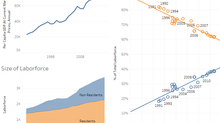Cutting Through the Noise: How Data Analytics Clears the Fog of Bias

In our modern, interconnected world, data analytics serves as a critical tool for making informed decisions. However, it's also vital for identifying and mitigating the various biases that can cloud our judgments. These biases typically fall into two categories: biases resulting from external influences, like media, and biases inherent in the process of data collection itself. Understanding both is essential for achieving clarity and fairness.
The Dual Challenge of Bias
External Bias: Sensationalism and Misinformation
What It Is: External bias occurs when external sources, such as the media or popular opinion, influence our perceptions and decisions.
Example: Consider how news reports often highlight extreme cases, like the sensational coverage of Singapore's public housing flats selling for over a million dollars. Despite such sales representing less than 5 percent of transactions, such stories can skew public perception, making it seem as though high prices dominate the entire market.
Internal Bias: Flaws in Data Collection
What It Is: Internal bias arises during the data collection and analysis process, often due to how data is gathered, who is included or excluded, and the methods used to interpret it.
Example: If a health study only includes middle-aged participants, its findings might not accurately apply to younger or older people, leading to skewed health advice that doesn’t cater to all demographics.
Addressing External and Internal Biases with Data Analytics
1. Sampling Bias
When It Happens: This occurs when the data collected does not accurately represent the population intended to be analyzed.
Example: A market research firm only surveys smartphone users about internet habits, missing insights from those who use desktop computers, potentially leading to incomplete or biased conclusions about overall internet usage patterns.
2. Confirmation Bias
When It Happens: This bias surfaces when data is interpreted in a way that confirms preexisting beliefs, overlooking contrary evidence.
Example: A project manager may only acknowledge project feedback that praises their approach, ignoring critical feedback that could help improve project outcomes.
3. Measurement Bias
When It Happens: This occurs when the tools or methods used to collect data are flawed.
Example: An online survey tool that malfunctions on older smartphones might exclude responses from users with older technology, skewing data towards the preferences and behaviors of those with newer devices.
4. Algorithmic Bias
When It Happens: This type of bias occurs when algorithms used in data processing generate skewed outcomes based on flawed input data or poor programming.
Example: A credit scoring system developed with historical data that underrepresents minority groups might result in unfairly low credit scores for those groups.
5. Exclusion Bias
When It Happens: It arises when certain segments of a population are systematically omitted from data analysis.
Example: If a consumer feedback analysis on a new product excludes non-English speaking customers, the results will not accurately reflect the sentiments of the entire customer base.
Conclusion
The journey of navigating through biases, whether stemming from external misinformation or internal data collection flaws, underscores the indispensable role of data analytics in today's decision-making landscape. By enhancing our data analytics practices—through rigorous methodologies, advanced tools, and ongoing education—we not only identify and mitigate biases but also unlock the full potential of data to inform and transform decisions.
Data analytics equips us with the clarity and precision necessary to cut through the noise of subjective perceptions and misleading information. It provides a foundation for decisions that are not just reactive to the loudest voices but are reflective of true, actionable insights. In a world where data is plentiful yet often underutilized or misinterpreted, committing to robust data analytics practices ensures that our strategies and policies are grounded in reality and fairness.
As we continue to rely on data to shape crucial business strategies, public policies, and everyday choices, the importance of data analytics becomes even more pronounced. It transforms raw data into valuable insights, guiding us toward more informed, equitable, and effective outcomes. Therefore, harnessing the power of data analytics is not just a technical necessity but a strategic imperative that enhances our ability to make well-informed decisions in an increasingly complex world.

























Comments